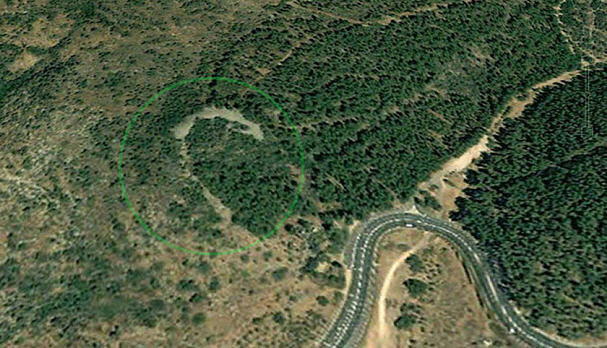A number of websites and blogs I subscribe published this bit of news today. The article from Salon.com is representative. The first paragraph reads:
A massive crescent-shaped stone structure has been discovered just a few miles northwest of the Sea of Galilee in Israel. Dating between 3050 B.C.E. and 2650 B.C.E., the monument is almost 500,000 cubic feet in volume and about 492 feet long. It seems hard to believe that such an enormous structure could have gone unidentified until now. In fact, archaeologists had assumed that the stone formation was part of a city wall; it wasn’t until Ido Wachtel, a doctoral student at the Hebrew University in Jerusalem, found that there actually wasn’t a city beside the “wall,” that he realized it was a stand-alone monument.
Hopefully most readers realize that, according to biblical history (and “secular” history as well), the land we call Israel wasn’t always Israelite turf. This is only a shocker to those unfamiliar with biblical content.
Readers of my divine council material familiar with the “Deuteronomy 32 worldview” will find Wachtel’s argument interesting. The monument is dated to ca. 3000 BC. That puts it well before the time of Abraham. Abraham is, of course, the pivotal figure in biblical history. The Old Testament has Abraham as the father of Isaac (by divine intervention; see Genesis 12, 15, 18), who was the father of Jacob, whose name was later changed to Israel. Israel was, as Deut. 32:8-9 (cp. Deut. 4:19-20) says, “Yahweh’s portion” of the nations of the world. Those two verses in Deuteronomy also say that, at the time of the Tower of Babel incident, the nations of the earth were disinherited by Yahweh and allotted to “the sons of God.”1 Consequently, it was only after the time of Abraham that the land we know as Israel was taken by Yahweh (Deut. 4:19-20) as his own.
The Mesopotamian context of the moon god Sin is also of interest with respect to Abraham (aka, Abram). The god Sin was securely associated with Harran (Akkadian: ḫarranu; ḥaran in the Old Testament).2 Biblical Haran was the place to which Terah (Abraham’s father) and his family (including Abram/Abraham) migrated from Ur.3 With all the above in mind, DDD’s brief comments on Sin are interesting:
The name Sîn (earlier Suen, Suin) survived in the Aramaic speaking world as the name of the moongod residing in Harran. This cult, already attested at the beginning of the second millennium in Mari, was promoted by Nabonidus who gave Sîn epithets such as ‘Lord/King of the Gods’, or even ‘God of Gods’ . . . . For this reason, the Aramaic name of the god Mrlhʾ (Marilahe, ‘Lord of the Gods’) has been identified with Sîn of Harran. Normally, the name of the moongod was Šah(a)r among the Aramaeans.
In Mesopotamia, the Sumerian and Babylonian moongod, Nanna/Sîn, was venerated everywhere, but Ur remained the centre of his cult.4
So, Yahweh, the God of the Bible and of Israel, took territory (Israel) from a foreign deity (Sin) who had been considered the god of gods — a decision in biblical history that was described in Genesis 11, the Tower of Babel (which obviously has a strong Mesopotamian context).
This is a cool example of archaeology coinciding with biblical messaging.
- Many English translations of the Bible will not have that reading. It comes from the Dead Sea Scrolls. The ESV and NRSV are two translations that incorporate the reading of the scrolls into their translation. The scrolls’ reading is the original reading of the Bible at this point. See my article on this subject for more details. ↩
- See “Haran,” Anchor Bible Dictionary. ↩
- I believe this Ur is not the one in southern Mesopotamia but Ura in northwest Mesopotamia, near Haran. See this post for more information. ↩
- M. Stol, “Sı̂n,” Dictionary of Deities and Demons in the Bible. ↩







I came across this news in io9.com and it never even crossed my mind to connect it back to Abraham! Now after reading this, I remember once hearing that Abraham would have been part of the pagan worship in Ur, and that they revered something like the moon god (!). But then Yahweh appeared to him and told him to leave his old faith behind and that He was the true God. Amazing discovery.
Very Cool! A window into that murky time in history that truly makes Genesis come alive.
Is there any significance to its location being near those mountains/hills?
none that I know of.
Reminds me of Jesus’ transfiguration maybe was at MT. Hermon standing on the “gates of hell” and watcher central, so to speak.
These ancient Jews probably realized Yahweh was choosing that land for that logic. “We’ll see who the real God of gods is here”.
This of course is so totally awesome!
Do you know much about the archaeology study bible?
I don’t.
Is there a theological or lingual chance that the Hebrew word and conception of sin was drawn from the this god?
No. The Hebrew word for sin = ḥaṭṭaʾt (Hebrew words with the consonants s-n do not equate to the concept of “sin”). Our English word “sin” has the following etymological history (from Webster):
sin:
[Middle English sinne, from Old English synn; akin to Old High German sunta sin and probably to Latin sont-, sons guilty, estimated]
Inc Merriam-Webster, Merriam-Webster’s Collegiate Dictionary. (Springfield, MA: Merriam-Webster, Inc., 2003).
Dr, do you know if there are any connections between Sin and Allah. The crescent moons made me think of it. Thanks!
The notion that Allah was originally a moon god is built on very flimsy evidence. DDD makes no connection. I’ve read that there is no inscriptional evidence for an Allah – moon god correlation, though *pre*- Islamic Arabia had moon god worship (Sin). Sin was popular in the Middle east as a moon god, along with Yareaḥ (the biblical Hebrew / northwest Semitic term for “moon”; cp. Ugaritic yrḫ = Yariḫ / Yarikh). Neither of those, obviously, corresponds to Arabic Allah. That name (Allah) is part of the Semitic “ʾeloah” / “ʾalahu/a” nouns for deity across that language family (root: ʾ-l-h, from whence comes the plural ʾ-l-h-m).
See http://www.ijfm.org/PDFs_IJFM/23_2_PDFs/Brown_WhoisAllahv2.pdf for a brief overview of this issue. Note that this PDF can be misread if you don’t understand the Semitic language family shares the above vocabulary. Vocabulary “sameness” of course does NOT denote theological or religious “sameness”.
The best thing on this is this book (which I don’t own since it’s $150 used on Amazon):
Tamara M. Green, The City of the Moon God: Religious Traditions of Harran (Religions in the Graeco-Roman World, vol. 114; Leiden: E. J. Brill, 1997)
“…a decision in biblical history that was described in Genesis 11, the Tower of Babel…”
Could you elaborate on this, or provide links to stuff that describes this idea? Sounds interesting. I think the ‘tower with its head in the heavens’ is describing a ziggurat, part of a temple complex, but I haven’t heard of this being connected to a larger portion of territory.
see the material on Deut 32:8-9 on my divine council website – http://www.thedivinecouncil.com
Mike,
A recent argument has been to connect Allah to the moon god via the ATRA-ḪASIS Epic (Here is the article someone sent me that this argument is found: http://shoebat.com/2014/09/16/new-archeological-discovery-moon-god-confirms-oldest-reference-allah/).
A part of this argument is here: COS reads, “ENLIL (Nanna’s father), counsellor of the gods, the warrior, Come, let us remove (him) from his dwelling!” (Hallo and Younger, The Context of Scripture [Leiden; New York: Brill, 1997–], 450). But the same line is translated by Stephanie Dalley as, “Then ALLA made his voice heard and spoke to the gods his brothers,’ Come! Let us carry Elil, the counselor of gods, the warrior, from his dwelling…” (Atrahasis, tablet i, OBV i, i-ii, trans. Stephanie Dalley, Myths from Mesopotamia, p. 10).
Would you mind commenting if you can on why Dalley has such a different name for the god (Alla vs. Enlil) and also if Alla has any correspondence to Allah? I just don’t know enough to comment, but I have read some fairly convincing arguments (to me anyway) from my limited knowledge on this stuff. So your thoughts would be much appreciated.
Thanks,
Doug
You CANNOT make an argument out of cuneiform syllables for Allah. While Akkadian/Babylonian.Assyrian is east Semitic, it is not alphabetic. Cuneiform sign meaning is not related to the sounds the signs make. Sumerian is especially problematic for this sort of thing. What Walid Shoebat (or basically anyone else in the pop Christian orbit) says about this sort of thing should be ignored.
Thanks Mike. I had never even heard of this Shoebat dude. btw, I figured out that I was misreading the Epic here. COS actually has a an empty [], while Dalley fills it in with “Alla.” Both have Enlil for the same line. So it was good to see that one god isn’t being replaced with another.
In a Logos search for both “allah” and “alla” in the same section, I came up with a single place name that is spelled both ways. It is Tell Deir ’Alla vs. Tell Deir ’Allah as spelled both ways in various journal articles and commentaries. So I guess what I’m wondering is if Alla would be a legitimate substitute for Allah. Perhaps in Aramaic, but not from Aramaic to Cuneiform?
Note that ʿAlla (as in Deir ʿAlla) is *properly* spelled with an “reversed apostrophe” as the first consonant. In Semitic the name of this letter is ʿayin – pronounced [roughly] ghayin. The “normal” apostrophe is incorrect – a typo. It’s a typical error when texts get retyped for digitization.
Islamic Allah is spelled (in Arabic) with initial aleph (not the letter above), though (see DDD on Eloah) Alla is a contraction of two words = al-ʾilāhu = ‘the god’.
The other letter (aleph) is a normal apostrophe or single quotation mark (silent – a glottal stop in Semitic languages).
This distinction doesn’t always come through when texts are retyped, either (for digital versions); hence you may find ʿAlla with the wrong apostrophe mark.